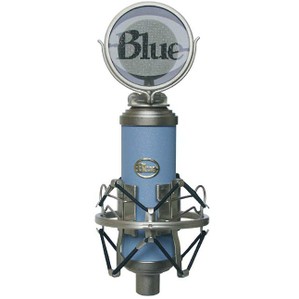Bluebird large diaphragm condenser microphone
![]()

Stunning design and build quality. Low self noise level. Stellar vocal and instrumental reproductions. Wide dynamic range.
![]()
No bass roll off feature. Included pop filter is inadequate. Shock mount looses tension rather quickly due to microphone’s weight.
![]()
Its style meets substance with the Bluebird large condenser microphone. The included Blue manufactured accessories are breathtaking at first sight, but quickly loose their appeal upon further investigation. Even still, with glimmering highs and rumbling lows, the Bluebird sings the sweetest tune
– Check the Current Price of this Product
– See What Amazon is Selling it for
Blue Bluebird Microphone Sings the Sweetest Tune
Glimmering highs and rumbling lows, the Bluebird sings the sweetest tune.
If Southern California went on a blind date with Miami Vice, the Bluebird large diaphragm microphone would be the spawn of the two. Sunny warm sound meets impenetrable style in this pastel and chrome masterpiece of innovative engineering. For the price, the Bluebird is hands down the best large diaphragm microphone this side of Ocean Drive.
Let’s start with the bad. The Bluebird does so much, so well, that the Antichrist himself could give a speech on this thing and we’d probably forgive him for it. But what it doesn’t do well, or rather what Blue the manufacturer doesn’t do well, is create useful accessories. Fresh out the box, the mic comes equipped with its own matte silver shock mount, the Birdcage, and matching pop filter, the Birdnest. Clever names yes indeed but even the average audiophile will want to throw both of these babies right out with the plastic they came in. The pop filter is crafted with the unwavering precision of an English timepiece; yet it fails to do one thing: stop the pops! I’m not sure why Blue didn’t simply include some sort of bass roll off feature to help diminish these unwanted peaks. At this price point, a feature such as that should be a given. The large baby bottle tubular design of the Bluebird also weighs down heavily on the included shock mount. This causes the mount to loose tension under even the slightest shock. Pop and shock aside, the quality, and finish of the microphone itself are otherworldly.
Inspired by a conglomerate of Blue microphone designs, including the Kiwi, Blueberry, and Dragonfly, the Bluebird out performs the bunch with ease. Its periwinkle encasing screams of summer breezes and open skies. I felt as if I needed a piano tie and salmon blazer just to touch this thing. Looks aside, sensitivity is the key here, and at minimal input levels the Bluebird sops up sound waves like grandma’s biscuits do maple syrup. Self noise is minimal and even in a non sound proof setting (i.e. apartment closet) the mic hovers at around -62db. Vocal and instrumental reproductions are also clear, and tight on a wide array of instruments; with sparkling highs and deep throaty basses left intact.
The Bluebird’s solid construction promotes crystal clear audio and is the ideal microphone for one’s recording and instrumentation needs. Its wide dynamic range allows for faithful sound output with minimal distortion. Even at its lowest levels, the Bluebird picks up the nimble variations of a fluttering tenor, as it does the sharp thump of an upright bass. In spite of the painfully pointless pop filter and weak shock mount, this bird is definitely one to sing about.
Technical Info:
Directional Pattern: Cardioid
Frequency Response: 20Hz-20kHz
Sensitivity: 27mv/Pa
Rated Impedance: 50ohms
Rated Load Impedance: Not less than 1kohm
Noise Level A-weighted: Not more than 7.5db
Max Output: 12dBV = 3.1V
Max SPL: 138db
Dynamic Range: 130db
Supply Voltage: +48V phantom power (+35V min)
Current Draw: 1.8mA
List Price: $699.99US
Were to Buy:

Speak Your Mind